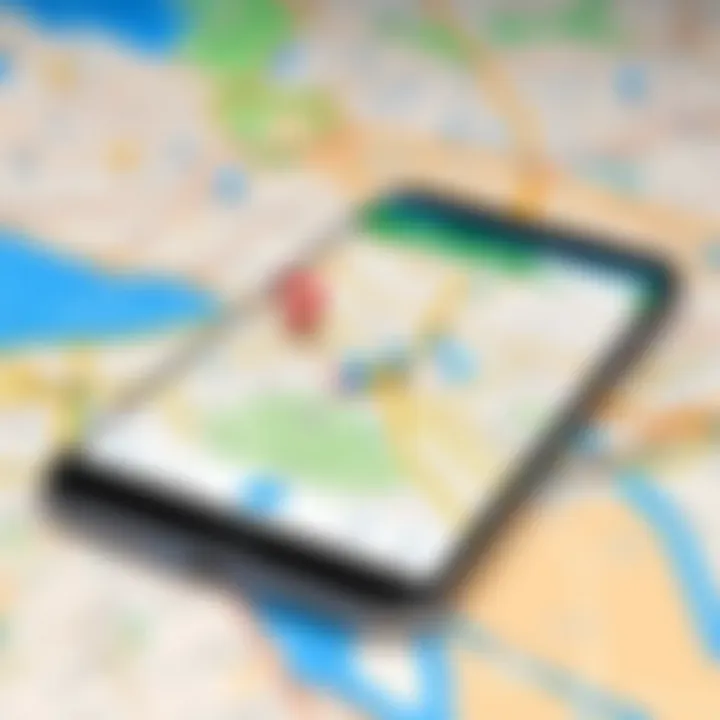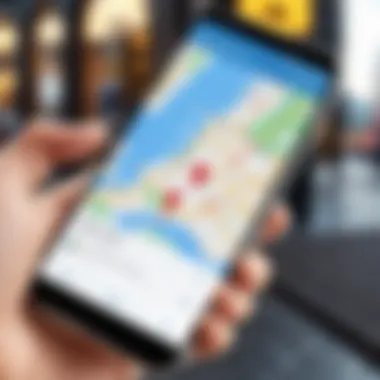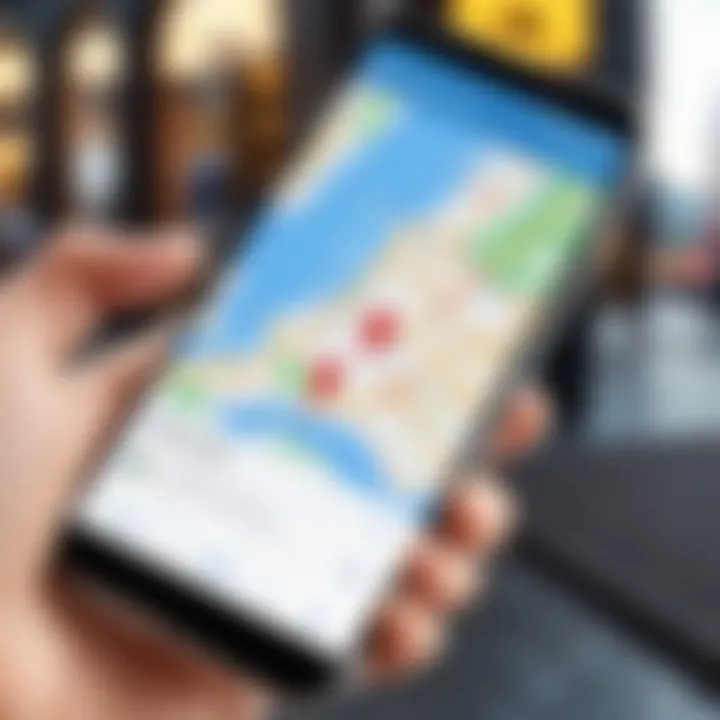How to Send Live Location: A Comprehensive Guide


Intro
In a world where connectivity is crucial, the ability to send and share live location has become an essential feature across various applications and devices. From keeping loved ones informed of your whereabouts to coordinating meet-ups at busy venues, sharing one's live location offers both practicality and security. This guide delves into diverse methods for sharing live location, analyzing key platforms, addressing privacy concerns, and providing clear, step-by-step instructions. Whether you are a technology enthusiast or a casual user, understanding how to send live location can enhance your digital interactions and ensure touchpoint reliability in navigating our interconnected lives.
Overview of the Technology
To appreciate the methods of sending live location, it is important to understand the technology behind it. Live location sharing typically relies on Global Positioning System (GPS) data, which allows devices to determine their precise location through satellite signals. Additionally, mobile networks may assist in enhancing location accuracy, especially in urban settings.
Key Specifications
- GPS Accuracy: Most modern smartphones achieve accuracy within a few meters.
- Data Usage: Sharing live location uses minimal data, making it efficient even on limited plans.
- Battery Consumption: Continuous location sharing may impact battery life, but most apps optimize usage to manage power efficiently.
Unique Selling Points
Live location sharing features stand out for several reasons:
- Real-Time Updates: The ability to send precise coordinates in real-time enhances safety.
- User-Centric Control: Users can choose whom to share their location with and for how long, promoting user choice over data sharing.
- Integration with Other Services: Many applications like Google Maps and WhatsApp integrate live location sharing with navigation and messaging, creating a seamless user experience.
"Sharing live location enhances not just the convenience of meet-ups, but also provides a layer of security."
Privacy Considerations
When engaging with location sharing technology, privacy is a paramount concern. Users must be mindful of the implications of sharing their location data.
- Informed Consent: Always verify who will have access to your location data.
- Time-Limited Sharing: Choose to share your location for specific periods.
- App Permissions: Regularly check app permissions to ensure only trusted applications can access your location.
By understanding the underlying technology and privacy aspects, individuals can utilize live location sharing to its fullest potential, enhancing both their safety and convenience in daily engagements.
Understanding Live Location
Live location sharing has become a critical component of modern communication and navigation strategies. This feature not only enhances the way people interact but also offers tangible benefits in daily activities. In the context of this article, understanding live location expands on the essential elements, associated benefits, and critical considerations involved.
Definition of Live Location
Live location is a technology that allows a user to share their current geographic position in real-time with others. This means that instead of getting periodic updates about where someone is, friends or colleagues can see exactly where the individual is located at any given moment. This immediacy promotes transparency and fosters trust in personal and professional networks.
Uses of Live Location Sharing
Personal Safety
Personal safety is a fundamental aspect of live location sharing. In emergency situations, sharing one’s location can facilitate quick assistance from friends or authorities. This particular function is especially popular among parents monitoring their children’s whereabouts or friends coordinating safely during nights out. The key characteristic of this application is its ability to provide peace of mind. It allows individuals to feel secure by knowing that they can provide their real-time location to trusted contacts. The unique feature here lies in the ability to alert others without needing to make a phone call or send a message, thus enhancing immediate response times.
Navigation Assistance
Navigation assistance represents another significant use case for live location sharing. It helps individuals and groups find the best routes and track progress in unfamiliar areas. Sharing live location while traveling provides real-time information about where someone is in relation to others. The essential characteristic of navigation assistance is its capacity to guide efficiently without constant communication. Users can stay on track and avoid getting lost. However, a specific downside is that reliance on live location can sometimes lead to increased distraction from surroundings, which could pose risks.
Event Coordination
Event coordination is an application where live location facilitates easier organizing and participation. Whether meeting for a social gathering or coordinating logistics for a business event, sharing live location can simplify the process. This feature allows participants to see who is nearby, ensuring no one gets left behind or lost. Its key characteristic is the streamlined communication it provides. Users can focus on the event itself rather than on logistics. However, a disadvantage might be the potential for privacy issues, as sharing location with multiple people can lead to discomfort or oversharing.
Technological Underpinnings
The technology behind live location sharing relies on several critical components that work together seamlessly. Understanding these underpinnings is essential for grasping how live location operates and what makes it succeed.
GPS Functionality
GPS functionality is foundational to live location sharing. Global Positioning System technology allows devices to determine their geographic position through satellite signals. This precise locating mechanism provides real-time data, making it possible to share locations accurately. The inherent advantage of GPS is its reliability and wide availability. However, a limitation could be its dependence on open skies, as urban environments with tall buildings might obstruct signals.
Mobile Network Synchronization
Mobile network synchronization enhances the effectiveness of GPS by facilitating efficient communication between devices. This synchronization ensures that location data can be transmitted quickly and reliably over cellular networks. It is particularly advantageous because it provides coverage in areas where GPS signals may not be strong. One downside, however, could be that mobile network connectivity varies significantly across regions, affecting the quality and consistency of shared locations.


Application Integration
Application integration refers to how different apps and services utilize live location capabilities. Various platforms like Google Maps and WhatsApp seamlessly allow users to share their location across different applications. The integration’s key characteristic is the versatility it offers users with different needs and preferences. This feature empowers a diverse audience to select the tools best suited for their requirements. A drawback, however, is that seamless integration might create a cluttered user experience if too many functionalities are bundled together, leading to confusion.
Popular Apps for Sharing Live Location
The selection of applications that facilitate live location sharing is crucial in modern communication. These platforms provide not just convenience, but also security. Users can stay connected with friends and family in real-time, enhancing personal safety, making navigation easier, and aiding in event coordination. Each app offers unique features and settings that cater to different needs, serving a diverse audience seeking efficient location-sharing methods.
Google Maps
Step-by-Step Guide
Google Maps stands out as a primary tool since it combines both global navigation and live location sharing into one platform. The step-by-step guide to sharing your live location includes:
- Open Google Maps on your mobile device.
- Tap on the blue dot indicating your location.
- Select "Share your location" from the menu.
- Choose the duration for which you wish to share it.
- Select contacts or get a shareable link.
This guide is beneficial not just for tech-savvy users, but also for those who may be less familiar with technology. The key characteristic of Google Maps is its GPS accuracy; it reliably shows your position to friends or family.
Quick Tip: This feature is useful when navigating unfamiliar areas or ensuring safety when traveling alone.
Privacy Settings
Privacy is a significant concern with sharing any location data. Google Maps offers simple privacy settings to control who can see your live location. Users can limit access to selected contacts or use a time limit for sharing. This flexibility makes it a popular choice, as users are able to maintain control.
In addition, Google Maps includes an option that allows users to stop sharing their location at any time. However, it is important users understand that location sharing can be seen even if the app is closed. Thus, awareness of one's digital footprint is necessary when using this feature.
How to Enable Live Location
WhatsApp has swiftly become a go-to for sharing locations within conversations. Enabling live location can be done by:
- Open an existing chat thread.
- Tap on the attachment icon.
- Select "Location" then tap on "Share live location."
- Choose the time frame for sharing.
The key characteristic of WhatsApp’s live location feature is how it integrates seamlessly with everyday communication. This app is beneficial due to its wide adoption, as most users already have it installed on their devices. It simplifies the process of sharing your whereabouts without switching apps.
Duration of Sharing
When sharing live location on WhatsApp, users can select how long they want to share their location—15 minutes, 1 hour, or 8 hours. This feature is essential for users who want temporary visibility. It reflects the modern need for temporary communication in an era where privacy is paramount.
However, the downside is that once time expires, sharing stops automatically and does not notify either party. This can lead to miscommunication if both the sender and recipient are unaware of the situation.
Apple Maps
Using Share My Location
Apple Maps allows users to share their location easily through the "Share My Location" feature. This is initiated by:
- Open the Apple Maps app.
- Tap on the blue dot.
- Select "Share My Location".
This choice is favorable because of its smooth integration with other Apple services. Users can share their location with other iOS devices seamlessly. However, some may find the app less intuitive compared to Google Maps.
Compatibility with iOS Versions
Compatibility is an essential consideration when sharing locations with Apple Maps. It is primarily suited for users operating on iOS devices. Ensuring that your Apple Maps is updated contributes to better functionality. This adaptability enhances the user experience across various iOS versions. Users should note that older devices may experience limitations with newer features.
Facebook Messenger
Enabling Location Sharing
Facebook Messenger leverages the vast social network. To enable location sharing on Messenger, follow these steps:
- Open a conversation.
- Tap on the plus sign (+) or the four dots icon.
- Choose "Location".
- Tap on "Share Live Location."


This platform is attractive for users who are already engaged in the Facebook ecosystem, creating an uncomplicated experience. The feature is valuable for arranging meet-ups or coordinating in events.
Viewing Shared Locations
Once a location is shared on Facebook Messenger, it can be viewed by participants in the chat. Users can see exactly where their friends are with real-time updates. However, the application does require internet access for updates to occur promptly. This reliance on connectivity can be a disadvantage in areas with poor service.
Technical Steps to Send Live Location
Understanding the technical steps to send live location is crucial for any user looking to navigate the complexities of modern technology. Choosing the right application, configuring settings, and executing the steps for sharing location are all critical elements. Mastering these processes enhances not only user efficiency but also safety and connectivity, which are paramount in today’s fast-paced environment.
Choosing the Right Application
Selecting an appropriate application for live location sharing can significantly impact the user experience. Popular choices include Google Maps, WhatsApp, and Apple Maps. Each of these apps has its own strengths, supporting different features for various needs. For example, Google Maps is renowned for its detailed mapping capabilities, while WhatsApp offers robust messaging features along with location sharing. Choosing wisely involves considering compatibility with devices, ease of use, and specific functions required by the user.
Configuring Location Services
Configuring location services is an essential step in enabling accurate and efficient live location sharing. Without the proper adjustments, users may face technical glitches or inaccuracies in location data, leading to a frustrating experience.
Mobile Device Settings
Mobile device settings serve as the foundation for location sharing. This feature allows applications to access location data, which is essential for sending live location accurately. Users need to activate location services through their mobile settings. Key characteristics include:
- Precision: Enabling high-accuracy mode can improve the location's accuracy significantly.
- Accessibility: Most smartphones have built-in options that enable users to customize location sharing settings according to their preferences.
However, one disadvantage is that excessive battery usage can occur when high-accuracy mode is activated. This is an important aspect to consider for prolonged use.
App Permissions
App permissions determine which applications can access location data. This is a necessary aspect to ensure privacy and security. When configuring these permissions, users must allow specific apps to access their location.
Some key characteristics are:
- Control: Users can selectively allow access for different apps, providing a layer of privacy.
- Transparency: Users receive notifications when an app requests access, maintaining user awareness.
However, overly restrictive permissions could hinder user experience, making it difficult to share locations effectively. It's a balance of security versus usability in this context.
Sending Your Live Location
The act of sending live location requires a clear procedure to ensure effectiveness. Proper execution can facilitate better communication, especially in urgent situations.
Step-by-Step Instructions
Following a systematic approach for sharing live location is beneficial to avoid confusion. Depending on which application is chosen, the steps may vary, but generally, they include:
- Open the application.
- Navigate to location sharing features.
- Choose the recipient for the location.
- Select how long to share the location.
- Confirm sending.
This methodical instruction helps users understand the process without feeling overwhelmed by technical jargon. However, it may require users to have preliminary knowledge of the app's interface.
Testing the Functionality
Testing functionality after sending live location is a critical step that should not be overlooked. Confirmation that the location is sent and received accurately builds confidence in using these technologies. Users can verify this by asking the recipient if they received the location correctly.
Key characteristics include:
- Accuracy: Testing ensures that the sent location is correct and up-to-date.
- Reliability: Successful checks indicate that the system is functioning as expected.
Nonetheless, a challenge lies in network connectivity issues that may affect the accuracy of the location sent. This testing step allows users to quickly identify and troubleshoot any potential problems.
Privacy Considerations in Live Location Sharing
In today's interconnected world, sharing live location data can be a useful tool, but it comes with significant privacy concerns. Understanding these concerns is crucial for anyone who wishes to use location-sharing technology effectively. The benefits of location sharing are clear, such as enhanced safety and improved connectivity. However, users must also recognize the potential risks, including unwanted tracking and privacy invasions. This section aims to provide clarity on these issues, outlining both the risks involved and best practices to ensure secure sharing of location data.
Understanding the Risks


The risks associated with sharing your live location are diverse. First, there is the possibility of unauthorized access. If someone gains access to your live location, they can track your movements, which can lead to potential harassment or stalking.
Moreover, location data can be mishandled by apps and services that do not prioritize user privacy. In some cases, developers might collect and sell this data to third parties, further exacerbating the risk of unwanted exposure. Data breaches are another risk, where sensitive user information can be leaked, leading to unwanted attention.
Best Practices for Safe Sharing
To mitigate these risks, users should adopt careful sharing practices. Here are some suggestions:
Selective Sharing
Selective sharing is an approach where users choose specifically with whom they want to share their location. This adds a layer of security and control. Instead of broadcasting your location to all contacts or publicly, you can limit it to trusted individuals only.
This method stands out due to its key characteristic of granularity. By controlling access, you minimize the risk of being tracked by individuals who might misuse the information. It is a beneficial choice for maintaining privacy without sacrificing the utility of location sharing.
An advantage of selective sharing is that it empowers users, putting them in the driver's seat regarding their information. However, it can also lead to complications if users forget to change their sharing settings after a particular event or situation.
Regularly Review Permissions
Regularly reviewing permissions is another vital practice. Apps often require location access to function correctly, but this can lead to long-term permissions that users may forget about. This oversight can expose users to unwanted tracking.
The key characteristic of this practice is its proactive nature. By routinely checking which apps have location access and modifying permissions as necessary, users protect their privacy effectively. This is an important aspect of digital hygiene.
A unique feature of regularly reviewing permissions is the ability to notice any changes or anomalies in permissions granted to apps. This vigilance helps defeat potential security threats before they escalate. While this practice requires a bit of effort, the trade-off is worth it for enhanced safety.
Future Trends in Location Sharing Technology
The advancements in location-sharing technology are rapidly changing how we interact with our environment and each other. Understanding these trends is vital for anyone looking to maximize their use of location-sharing capabilities. The intersection of GPS technology, mobile applications, and smart devices creates both opportunities and challenges. This section focuses on the specific elements that will shape the future of location sharing, its benefits, and the considerations one must keep in mind.
Advancements in GPS and Location Services
Modern GPS technology has improved significantly. New satellites contribute to more accurate positioning. This means users can expect better reliability in navigation and location sharing. Advanced techniques, such as multi-band GPS, allow for precise tracking in urban areas where signals often suffer from interference. Moreover, enhancements to algorithms that process location data enable faster updates. These aspects make GPS an essential component of location-sharing features in apps.
Integration with IoT Devices
Smart Home Applications
Smart home systems are increasingly integrating location sharing functionalities. By leveraging location data, these systems can automate tasks, such as adjusting thermostats or enabling security features when users arrive home. This responsiveness enhances daily life for users. Notably, devices like Google Nest enable these features. However, they also raise privacy concerns. If not properly secured, the sharing of one's location can expose users to risks. Thus, while beneficial, careful consideration of security measures is necessary.
Wearable Technology
Wearable devices have also stepped into the location-sharing landscape. Gadgets like smartwatches can share live location data. This feature provides peace of mind, especially for those engaging in outdoor activities. The key characteristic is convenience; users can share their whereabouts easily without needing to access their phones. However, a potential downside is battery depletion, as constant GPS usage can drain power. Balancing functionality with battery life is a current challenge for wearables.
Social Implications of Location Sharing
Impact on Communication
The way we communicate is transformed by location sharing. Knowing another's exact location can enhance coordination. For instance, when meeting friends, they can see real-time updates of arrival times. This efficiency is a key advantage of live location sharing. On the flip side, constant location updates can lead to feelings of surveillance, impacting personal relationships. Finding a balance between facilitating communication and maintaining personal space is an ongoing challenge.
Changes in Personal Interactions
The concept of trust and privacy in personal interactions is evolving. Sharing location data alters how people perceive commitment and availability. Friends and family may expect someone to be reachable at all times, which can create stress. While facilitating connections, it can also lead to misunderstandings about availability. Moreover, one must consider the implications of sharing sensitive information in public spaces. Managing these dynamics is crucial in the modern digital age.
"Emerging technologies will surely redefine how we perceive and utilize location-sharing in our daily lives."
End
In this article, we have delved deeply into the various methods and technologies that facilitate live location sharing. The importance of this topic cannot be overstated, especially in an era where connectivity and real-time information are paramount. Live location sharing serves multiple purposes, ranging from enhancing personal safety to enabling effective navigation and event coordination.
Summary of Key Points
Here are some key points we covered in this comprehensive guide:
- Understanding Live Location: We defined what live location is and explained its significance in daily life. The uses range from personal safety applications to assisting with navigating unfamiliar areas.
- Popular Apps for Sharing Live Location: We explored well-known applications like Google Maps, WhatsApp, Apple Maps, and Facebook Messenger. Each of these platforms has unique features to enhance the user experience.
- Technical Steps to Send Live Location: A detailed look at how to choose the right application, configure necessary location services, and actually send one's live location was presented.
- Privacy Considerations: Recognizing the risks involved in sharing one's live location is crucial. We discussed best practices that individuals should follow to ensure safe sharing.
- Future Trends: We glanced at advancements in GPS technologies, integration with Internet of Things (IoT) devices, and social implications of location sharing.
Final Thoughts
Live location sharing is not just a technological convenience; it has become an integral part of modern life. Its benefits enhance personal safety, streamline coordination, and foster communication. However, users must be cognizant of the privacy implications and take proactive measures to safeguard personal information. As technology progresses, staying informed about the tools and best practices around live location sharing is essential for maximizing its advantages while minimizing risks. By understanding the ins and outs of these technologies, individuals can leverage them effectively in everyday situations.
As we look to the future, the ability to share live location will likely continue to evolve. Keeping pace with these changes will empower users and enhance their interactions with the world.







